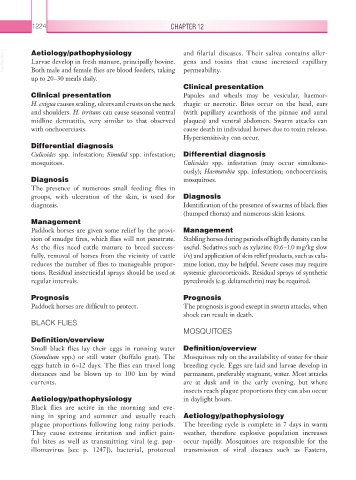Page 1249 - Equine Clinical Medicine, Surgery and Reproduction, 2nd Edition
P. 1249
1224 CHAPTER 12
VetBooks.ir Aetiology/pathophysiology and filarial diseases. Their saliva contains aller-
gens and toxins that cause increased capillary
Larvae develop in fresh manure, principally bovine.
Both male and female flies are blood feeders, taking
up to 20–30 meals daily. permeability.
Clinical presentation
Clinical presentation Papules and wheals may be vesicular, haemor-
H. exigua causes scaling, ulcers and crusts on the neck rhagic or necrotic. Bites occur on the head, ears
and shoulders. H. irritans can cause seasonal ventral (with papillary acanthosis of the pinnae and aural
midline dermatitis, very similar to that observed plaques) and ventral abdomen. Swarm attacks can
with onchocerciasis. cause death in individual horses due to toxin release.
Hypersensitivity can occur.
Differential diagnosis
Culicoides spp. infestation; Simulid spp. infestation; Differential diagnosis
mosquitoes. Culicoides spp. infestation (may occur simultane-
ously); Haematobia spp. infestation; onchocerciasis;
Diagnosis mosquitoes.
The presence of numerous small feeding flies in
groups, with ulceration of the skin, is used for Diagnosis
diagnosis. Identification of the presence of swarms of black flies
(humped thorax) and numerous skin lesions.
Management
Paddock horses are given some relief by the provi- Management
sion of smudge fires, which flies will not penetrate. Stabling horses during periods of high fly density can be
As the flies need cattle manure to breed success- useful. Sedatives such as xylazine (0.6–1.0 mg/kg slow
fully, removal of horses from the vicinity of cattle i/v) and application of skin relief products, such as cala-
reduces the number of flies to manageable propor- mine lotion, may be helpful. Severe cases may require
tions. Residual insecticidal sprays should be used at systemic glucocorticoids. Residual sprays of synthetic
regular intervals. pyrethroids (e.g. deltamethrin) may be required.
Prognosis Prognosis
Paddock horses are difficult to protect. The prognosis is good except in swarm attacks, when
shock can result in death.
BLACK FLIES
MOSQUITOES
Definition/overview
Small black flies lay their eggs in running water Definition/overview
(Simulium spp.) or still water (buffalo gnat). The Mosquitoes rely on the availability of water for their
eggs hatch in 6–12 days. The flies can travel long breeding cycle. Eggs are laid and larvae develop in
distances and be blown up to 100 km by wind permanent, preferably stagnant, water. Most attacks
currents. are at dusk and in the early evening, but where
insects reach plague proportions they can also occur
Aetiology/pathophysiology in daylight hours.
Black flies are active in the morning and eve-
ning in spring and summer and usually reach Aetiology/pathophysiology
plague proportions following long rainy periods. The breeding cycle is complete in 7 days in warm
They cause extreme irritation and inflict pain- weather, therefore explosive population increases
ful bites as well as transmitting viral (e.g. pap- occur rapidly. Mosquitoes are responsible for the
illomavirus [see p. 1247]), bacterial, protozoal transmission of viral diseases such as Eastern,

